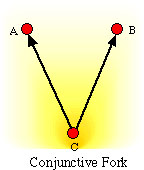Conjunctive fork is defined by the following four conditions:

(1) P(AB|C) = P(A|C)P(B|C)(2) P(AB|~C) = P(A|~C)P(B|~C)(3) P(A|C) P(A|~C)(4) P(B|C) P(B|~C)
It is said that from these conditions, (5) follows:
(5) P(AB) P(A)P(B)
All right; how do you prove this? For a proof of this sort, it is important to separate the logical part and the probabilistic part, as follows:
First, notice the logical property that A is equivalent with a disjunction of AC and A~C. (We will carry out our proof in logical terminology, rather than in set-theoretical terminology, but since the two ways are interchangeable with minor modifications, the validity will not be affected.) Then, notice that the probability of this disjunction is equal to that of A (by a theorem of probability calculus; see Uchii 1995, section 6.7). Thus,
(6) P(A) = P(ACÉA~C) = P(AC) + P(A~C).
By a similar reasoning,
(7) P(B) = P(BCÉB~C) = P(BC) + P(B~C)
(8) P(AB) = P(ABCÉAB~C) = P(ABC) + P(AB~C).
Next, we have to remember the multiplication theorem (which directly follows from the definition of conditional probability), such as
(9) P(AC) = P(C)P(A|C).
Then, from (6) and (7) we obtain, respectively,
(10) P(A) = P(AC) + P(A~C) = P(C)P(A|C) + P(~C)P(A|~C)(11) P(B) = P(BC) + P(B~C) = P(C)P(B|C) + P(~C)P(B|~C).
As for (8), things are a bit more complicated, but essentially the same reasoning applies. For instance, by the multiplication theorem
(12) P(ABC) = P(C)P(AB|C) = P(C)P(A|C)P(B|AC).
But you already know that (1) implies the screening-off effect (Salmon 1980, 144; Salmon 1981, 160), i.e.
(13) P(B|AC) = P(B|C),
so that (12) implies
(14) P(ABC) = P(C)P(A|C)P(B|C).
Applying the same consideration to the other item in the right-hand side of (8) too, we obtain
(15) P(AB) = P(C)P(A|C)P(B|AC) + P(~C)P(A|~C)P(B|~C).
The rest of the proof is simply algebraic. In order to show (5), we may show that
(16) P(AB) - P(A)P(B) 0.
In order to avoid clumsy formulas, let us replace the probabilistic expressions with an alphabet, as follows:
P(A) = a, P(B) = b, P(C) = c, P(AB) = w,
P(A|C) = u, P(B|C) = v, P(A|~C) = r, P(B|~C) = s.
Then, our equations (10), (11), (15), and (16) can be written as:
(10') a = cu + (1- c)r(11') b = cv + (1- c)s(15') w = cuv + (1- c)rs(16') w - ab 0.
As you can easily calculate,
(17) w - ab = c(1 - c)(u - r)(v - s).
And since c is between 0 and 1, given the conditions (3) and (4), we clearly have (16'). Q.E.D.
The preceding proof is essentially the same as that in Reichenbach (1956), p. 160. But notice that Reichenbach uses non-standard expression for conditional probability; his P(C, A) means our P(A|C), and Salmon (1967) follows this Reichenbach way!
@
References
Reichenbach, H. (1956) The Direction of Time, University of California Press, 1956.
Salmon, W. C. (1967) The Foundations of Scientific Inference, University of Pittsburgh Press, 1967.
----- (1980) "Probabilistic Causality", Sosa & Tooley VIII.
----- (1981) "Causality: Production and Propagation", Sosa & Tooley IX.
Sosa E. and Tooley, M., eds. (1993) Causation, Oxford University Press, 1993.
Uchii, S. (1995) ÈwNwüåA¢EvzÐA1995B